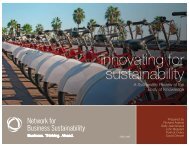embedding sustainability in organizational culture - Network for ...
embedding sustainability in organizational culture - Network for ...
embedding sustainability in organizational culture - Network for ...
Create successful ePaper yourself
Turn your PDF publications into a flip-book with our unique Google optimized e-Paper software.
Chapter 1: 3: Introduction Foster<strong>in</strong>g Commitment<br />
20<br />
✔ SuppoRt: Make it easier <strong>for</strong> employees to make choices that favour<br />
<strong>susta<strong>in</strong>ability</strong><br />
• Make it easier <strong>for</strong> employees to make <strong>susta<strong>in</strong>ability</strong> decisions at<br />
work<br />
• Provide support <strong>for</strong> employees to make <strong>susta<strong>in</strong>ability</strong> decisions <strong>in</strong><br />
their personal lives such as transit pass programs, ride-shar<strong>in</strong>g, and<br />
secure bicycle park<strong>in</strong>g<br />
Companies can build a <strong>culture</strong> of <strong>susta<strong>in</strong>ability</strong> by mak<strong>in</strong>g it easier <strong>for</strong> employees<br />
to make susta<strong>in</strong>able choices at work and <strong>in</strong> their personal lives. As an example,<br />
Shrivastava (1995) cites management’s provision of corporate vans <strong>for</strong> employee<br />
ride-shar<strong>in</strong>g as re<strong>in</strong><strong>for</strong>c<strong>in</strong>g its commitment to <strong>susta<strong>in</strong>ability</strong> and build<strong>in</strong>g employee<br />
morale. Another company has a fleet of smart cars <strong>for</strong> work-related travel dur<strong>in</strong>g<br />
the day so that employees can still take transit to and from work (NBS, 2010).<br />
Ramus and Steger (2000) found that employees were more likely to develop and<br />
implement creative ideas that positively affected the natural environment when they<br />
perceived supervisory encouragement <strong>for</strong> do<strong>in</strong>g so. Bansal (2003) also found that<br />
management’s support of employees’ <strong>susta<strong>in</strong>ability</strong> activities contributes to a <strong>culture</strong><br />
of <strong>susta<strong>in</strong>ability</strong>. In the <strong>in</strong>novation literature, Stop<strong>for</strong>d and Baden-Fuller (1994)<br />
expla<strong>in</strong> how chief executives of organizations <strong>in</strong> their study supported learn<strong>in</strong>g by<br />
remov<strong>in</strong>g barriers to teamwork and collaboration through the abolition of separate<br />
d<strong>in</strong><strong>in</strong>g rooms <strong>for</strong> managers and teams.<br />
Support<strong>in</strong>g is a practice that appears to be supported empirically.<br />
assessment: Supported<br />
lEvERagE: condone, encourage and support grassroots ef<strong>for</strong>ts; try to<br />
amplify the effect of activities <strong>in</strong>itiated by <strong>in</strong>dividuals or small groups<br />
• Provide small grants or time off <strong>for</strong> <strong>susta<strong>in</strong>ability</strong> projects launched<br />
by employees<br />
• Provide company time to meet about conceiv<strong>in</strong>g and launch<strong>in</strong>g CSR<br />
<strong>in</strong>itiatives<br />
Another way to embed <strong>susta<strong>in</strong>ability</strong> is to leverage the grassroots ef<strong>for</strong>ts of<br />
your employees. Practitioners have suggested that leverag<strong>in</strong>g can be a way to<br />
let employees drive positive change (NBS, 2010; Willard, 2009). Suggestions<br />
to leverage ‘grassroots’ ef<strong>for</strong>ts <strong>in</strong>clude provid<strong>in</strong>g company time to meet about<br />
conceiv<strong>in</strong>g and launch<strong>in</strong>g <strong>susta<strong>in</strong>ability</strong> <strong>in</strong>itiatives (Strandberg, 2009) or provid<strong>in</strong>g<br />
small grants to support projects <strong>in</strong>itiated by employees or stakeholders (NBS, 2010).<br />
Bansal (2003) notes that <strong>in</strong> one company, the ef<strong>for</strong>ts of one <strong>in</strong>dividual to encourage<br />
recycl<strong>in</strong>g resulted <strong>in</strong> a recycl<strong>in</strong>g table at which all <strong>organizational</strong> members could<br />
donate or pick up used office supplies.<br />
The practice of leverag<strong>in</strong>g did not receive any specific empirical attention <strong>in</strong> the<br />
research reviewed here.<br />
assessment: proposed but not tested<br />
captuRE quick w<strong>in</strong>S: identify and complete changes related to<br />
<strong>susta<strong>in</strong>ability</strong> that are less demand<strong>in</strong>g of resources or that result <strong>in</strong> readily<br />
identifiable benefits (also called ‘low hang<strong>in</strong>g fruit’)<br />
• Start with the ‘low hang<strong>in</strong>g fruit’<br />
Identify<strong>in</strong>g ‘quick w<strong>in</strong>s’ or ‘low hang<strong>in</strong>g fruit’ is cited by practitioners as a means to<br />
build momentum <strong>for</strong> <strong>susta<strong>in</strong>ability</strong> with<strong>in</strong> the organization. Dunphy and colleagues<br />
(2003) suggest small successes can be used to overcome areas of resistance.<br />
Interface started with ‘quick w<strong>in</strong>s’ but after they exhausted the ‘low hang<strong>in</strong>g fruit’<br />
they found that they needed to develop a more structured plan <strong>for</strong> mov<strong>in</strong>g to the<br />
next state (DuBose, 2000).<br />
In the quality literature, Manley (2000) expla<strong>in</strong>s that captur<strong>in</strong>g quick w<strong>in</strong>s is an<br />
important tactic <strong>for</strong> demonstrat<strong>in</strong>g that a new approach is effective <strong>in</strong> order to<br />
encourage already-enthusiastic supporters to get beh<strong>in</strong>d future quality improvement<br />
programs.<br />
Captur<strong>in</strong>g quick w<strong>in</strong>s appears to be a practice well suited to build<strong>in</strong>g momentum;<br />
however, none of the empirical work reviewed here specifically exam<strong>in</strong>ed its<br />
effectiveness and at what stage along the <strong>susta<strong>in</strong>ability</strong> trajectory it is best employed.<br />
assessment: proposed but not tested<br />
REcognizE: Show awareness of, approval of, or appreciation <strong>for</strong> ef<strong>for</strong>ts to<br />
implement <strong>susta<strong>in</strong>ability</strong> through <strong>in</strong><strong>for</strong>mal accolades<br />
• Publicly recognize employees at staff meet<strong>in</strong>gs<br />
• Create <strong>susta<strong>in</strong>ability</strong> awards<br />
• Hold celebrations
















